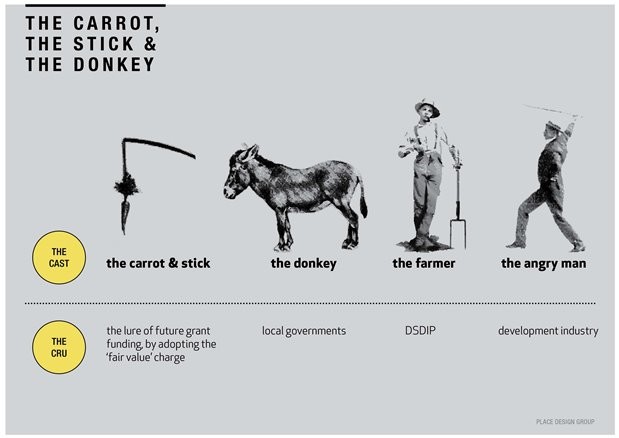The central pillar and largest change proposed to the Queensland infrastructure charges framework is all about the carrot, the stick and the angry men. In essence, if you hang a big enough carrot on a stick in front of a donkey, the hope is that it will entice him to walk where you want without having to forcibly whip or steer the donkey.
Now of course this is an ‘analogy’ whereby the donkey is our local governments, the farmer who tied the carrot to the stick, the State, and the angry men standing by hoping to take a swing at the donkey, our development industry. It is a rather crude way of explaining the changes to our proposed infrastructure charges but sums up the situation very well.
 Chris Isles, Director PLACE Design Group.
Chris Isles, Director PLACE Design Group.
The State has basically identified that the current maximum charge being used by a number of Councils recoups between 10-20 per cent more than it will cost them in the future to deliver the same infrastructure. So to sure this up the State has linked access to infrastructure funding and grants programs to the adoption of infrastructure charges no greater than the identified fair value charges schedule.
The reform process has so far included a series of 13 workshops across 15 months which I have been lucky enough to be a part of in my role as committee member of the Urban Development Institute Association (UDIA) Queensland. After all the discussion and expert guidance it would be fair to assume the framework would be perfect, shouldn’t it? Well for some the changes are significant and very positive but for others it may be reasonable to question ‘what has changed’?
There is no doubt that developers of greenfield projects and larger infill projects are the winners, whilst the majority in the industry who never deliver trunk infrastructure will perhaps consider themselves left out of this reform package.

The positives I have identified:
-
Fair Value - A new Fair Value mechanism which links local government access to future State government funding and grants to the adopted infrastructure charges no greater than the identified fair value charges schedule
-
Cross-crediting - Mandatory ‘cross-crediting’ across infrastructure networks
-
Credit Mandate - Mandating credits for existing use rights
-
Rules of Provision and Quantification - Clearer rules relating to the provision and quantification of credits, offsets and refunds
-
Actual Value - Availability of offsets and refunds at actual value rather than ‘planned value’
-
Trunk - The ability to apply to have infrastructure ‘deemed’ as trunk, even if it has not been identified as trunk in a LGIP
-
Charges Notice - The ability to issue a new adopted infrastructure charges notice in response to a permissible change.
-
Interrogation - Third party interrogation of local government infrastructure plans
The concerns:
-
Conversion of Particular Non-Trunk Infrastructure - The application, assessment and appeal process for the ‘conversion’ all need to be completed prior to construction beginning, which is not practical or necessary. In addition, clear guidelines need to be provided to guide the trunk conversion decision making process.
-
Potential Impacts on DA Timeframes – the current Bill seems to expect Councils/Developers to have to lock in Offsets as part of DA ICNs. This will result in DA delays and is potentially not possible due to detail required typically being part of Op Works process.
-
Offsets, Credits & Refund Process - The process for determining Offsets, Credits and Refunds is to be determined on a Council by Council basis with no consistent guidance or regulation from the State. This will create confusion and inconsistency across the State.
-
Refund Timing - There is still no certainty with regards to timing of refunds as they are to be subject to an IA.
-
Third Party Reviews – the Bill is silent on the nature of the review. Clarity on the process and timing should be provided.
-
Gold Plating of Non-Trunk Infrastructure – The Bill does nothing to end this practice
Is it little wonder I have turned to creating ‘characters’ to explain the reforms to my colleagues and clients considering the exhaustive process I have seen to date and the complexity of the current proposed SPIC Bill.
The donkey, the carrot and the angry men is my way to keep the excitement and momentum needed in this long and important process. Whilst it still continues today and may continue for some time, where it stands, I believe there are still many questions to be answered.
Chris Isles, Director PLACE Design Group.

